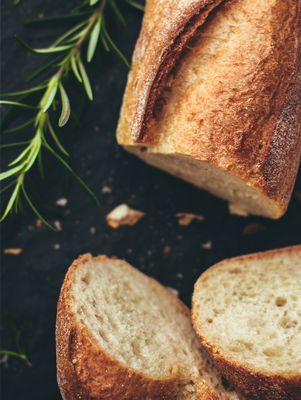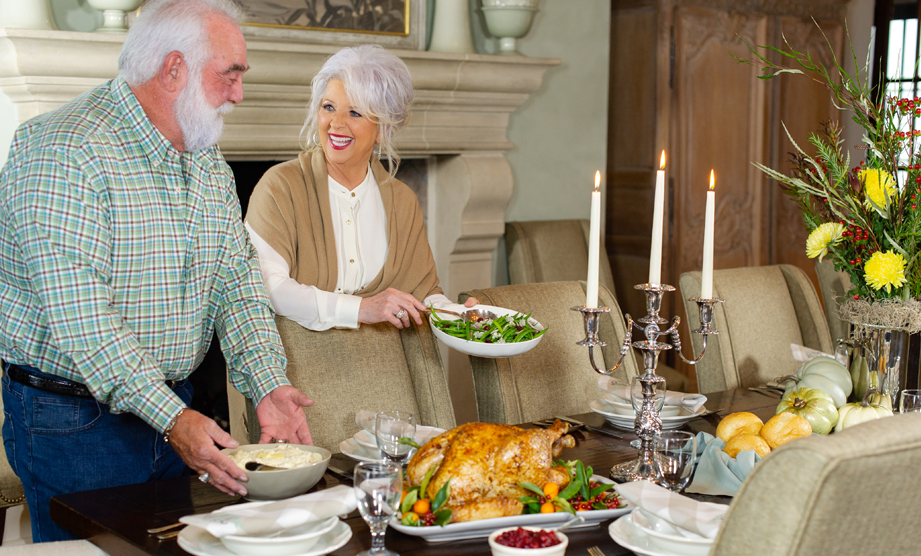Organic Wheat Baguette
By Deen Brothers
JUMP TO RECIPE
Difficulty: Easy
Prep time: 50 min ; Inactive: 12 hr 30 min
Cook time: 25 min
Servings: Two 14-inch baguettes
Ingredients
- 1/8 teaspoon active dry yeast
- 1/4 cup very warm water 105 to 115 degrees F
- 1/4 cup plus 2 tablespoons very cool water 70 to 72 degrees F
- 1 cup organic unbleached all-purpose flour
- 1/4 cup very warm water 105 to 115 degrees F
- 1/8 teaspoon active dry yeast
- 1 7/8 cups organic whole wheat flour
- 1/2 cup very cool water 70 to 72 degrees F
- 3 tablespoons organic unbleached all-purpose flour
- 3 tablespoons organic rye flour
- 2 1/4 teaspoons kosher salt
- 1/4 teaspoon barley malt syrup
- Oil
- Coarse cornmeal
Directions
For the starter: Combine the yeast and very warm water in a 2-quart plastic or glass container and whisk together until the yeast has dissolved. Allow the mixture to stand for 3 minutes. Add the flour and cool water and stir vigorously with a wooden spoon or your hand for 1 minute, until a smooth, somewhat elastic batter has formed. The starter will be thick and stretchy. It gets softer and thinner after it has risen.
Scrape down the starter from the sides of the container and cover the container with plastic wrap. Mark the height of the starter and the time on a piece of tape on the side of the container so you can see how much it rises. Make sure it has room to triple in volume. Let the starter rise at room temperature (75 to 78 degrees F) for 6 to 8 hours. Or let it rise for 1 hour at room temperature, then chill it in the refrigerator for 8 hours or overnight.
Remove it from the refrigerator and let it sit at room temperature for 3 to 4 hours to warm up and become active before use. When it is ready, it will have tripled in volume, and lots of bubbles and small folds will appear on the surface. Set aside 1/2 cup for the baguettes, and use the remaining starter for another bread recipe. The starter should be used in the next 2 to 4 hours, before it begins to deflate. If you use the starter while it’s still cold from the refrigerator, be sure to compensate for the temperature by using warm water (85 to 90 degrees F) in your dough instead of the cool water specified in the recipe.
For the baguette: Combine the very warm water and the yeast in a measuring cup and stir to dissolve the yeast. Let stand for 3 minutes. Combine the water and yeast, whole-wheat flour, cool water, all-purpose and rye flours, salt and malt syrup in the bowl of an electric stand mixer fitted with a dough hook. Combine on medium-low speed until all the flour is moistened and gathers into a ball of dough, 3 minutes. Slide the dough down from the top of the hook (to be sure all of the dough will be evenly kneaded), increase the speed to medium and knead the dough for 3 more minutes. Slide the dough down from the hook again, increase the speed to medium-high and continue kneading until the dough begins to slap the sides of the bowl and is beginning to pull up from the bottom of the bowl but does not clean the bottom of the bowl, another 3 to 4 minutes. The dough should be about 80-percent developed at this point. It should have some strength and elasticity but it will be very soft and a little sticky and you will not be able to pull a transparent sheet without having it tear. The dough temperature should be around 77 degrees F.
Put the dough in an oiled bowl that is large enough to allow it to almost double, cover it with oiled plastic wrap, and allow it to rise for 1 hour. It should feel puffy but it will not have doubled. Gently fold the dough in from the sides to the middle to deflate it, turn it over so the smoother bottom side is up, cover it, and let it rise again for 45 to 50 minutes. The dough will almost double during this second rest and it should feel strong and supple by the end of the t
Pre-shape each piece by patting it into a small rectangle about 8 by 4 1/2 inches with lightly floured hands, positioning them so the short sides are at the top and the bottom of the rectangle. If the dough sticks to the work surface, lift it gently with a dough scraper and lightly re-flour the surface. Also keep your hands lightly floured so the dough doesn’t stick to them and tear. Starting with the upper edge of the dough, gently fold the top third down and the bottom third up, like a business letter, so you have three equal layers. Seal the seam at the top edge and turn it so the seam is on the bottom. The pre-shaping prepares for the final lengthening of the baguette. Cover these shapes with the oiled plastic wrap and let them rest on the work surface until they feel puffy and have almost doubled. This could take anywhere from 30 minutes to 1 hour or more depending on the temperature of the dough and whether the pre-shaping was tight or loose.
While the dough rests, prepare a proofing pan for the baguettes by lining a 17- by 12-inch rimmed baking sheet with baker’s linen so it overlaps the sides, and sprinkle it with a moderate amount of flour; or a heavy smooth cotton towel sprinkled generously with flour; or just line the pan with parchment paper and sprinkle the parchment with a moderate amount of flour. Use a dough scraper to lift one of the almost-doubled pieces of dough and gently flip it over onto the lightly-floured work surface. With lightly-floured hands, pat the dough gently into an oval shape about 10 by 4 inches with the long edge facing you. (Don’t be too heavy-handed with the patting; you want to preserve some of the gas bubbles in the dough so you’ll have a nice airy crumb in your finished baguette.) Shape each piece into a baguette. The baguettes should be 13 to 14 inches long and about 1 3/4 inches in diameter. Don’t go beyond 14 inches or they won’t fit on a baking stone. This length is good even if you’re baking on a baking sheet without a stone because it will give you a good crust-to-crumb ratio for a piece of dough this size. The longer you make it, the less crumb you have on the inside of the loaf. Place one loaf lengthwise on the prepared baking sheet touching against the edge of the pan (be sure the edge of the pan is covered by part of the floured cloth).
Pull up a 3-inch pleat of cloth to separate the two loaves and place the second loaf on the pan next to the first loaf. Pull up another pleat of cloth on the outside of the second loaf to support it while it rises. If you’re using a parchment-lined pan, place the loaves about 2 inches in from the sides and leave 3 to 4 inches between the two loaves. Cover the loaves with oiled plastic wrap and let them rise until they have almost doubled. They should look plump and hold a slight indentation when pressed lightly with your finger. This could take 1 or 2 hours depending on the temperature of the dough and how tightly the baguette is shaped. Baking them when they’re slightly under-proofed guarantees more oven spring, which contributes to a more open, airy crumb in the finished loaf.
Thirty minutes before baking, preheat the oven to 480 degrees F.
Prepare the oven by placing a cast-iron skillet and a smaller pan (a mini loaf pan) on the floor of the oven or on the lowest possible rack in an electric oven. Place an oven rack two rungs above the cast-iron pan, and if you have one, put a baking stone on the rack. Fill a plant sprayer with water. Fill a teakettle with water and have a metal 1-cup measure with a straight handle available near the kettle. Five to 10 minutes before the loaves are ready to bake, turn the water on to boil, and carefully place 2 or 3 ice cubes in the small loaf pan in the bottom of the oven. This helps to create moisture in the oven prior to baking. At the same time, 5 to 10 minutes before the loaves are ready to bake, sprinkle a wooden peel with coarse cornmeal or polenta and gently lift each loaf from the proofing pan onto the peel. The easiest way to do this is to put one hand under each end of the loaf and gently scoot them in toward the center so the middle will be supported during the move. Try not to stretch the loaves beyond 14 inches, and leave enough space between to allow for spreading in the oven. Leave them uncovered so a light skin forms on the surface, which makes the loaves easier to score- scoring is the term bread bakers use for cutting the loaves before baking. (If you’re baking without a stone, just leave the risen loaves on the parchment-lined baking pan and remove the plastic wrap for the last few minutes of proof time.) When the loaves are ready, use a lame or a sharp razor blade to make three or four slashes down the length of each baguette. The cuts should run from one end of the loaf to the other, rather than across it, and the blade should be held at a 30-degree angle to the loaf to create cuts that will pop open in the oven. Use the plant sprayer to mist the loaves evenly with water. Slide the loaves onto the baking stone, being mindful not to stretch them or they’ll fall off the end of the stone.
Pour 1 cup boiling water into the skillet and immediately shut the oven door. After about 1 minute, quickly mist the loaves 6 to 8 times, then shut the oven door. Check the loaves after 12 minutes and rotate them if necessary to insure even browning. Bake the baguettes until they are uniformly golden brown in color and sound hollow when tapped on the bottom, 23 to 25 minutes. Cool them on a wire rack and enjoy them slightly warm or at room temperature. Baguettes are best eaten the same day they are baked.
Notes
We used unbleached bread flour with a protein content of 12.7 percent for this dough. The flour in the poolish had a protein content of 11.5 percent. If you can’t find coarse whole wheat flour, using regular organic whole wheat flour will be fine.
